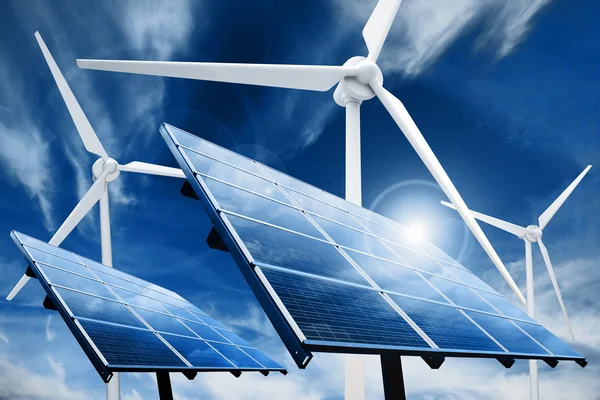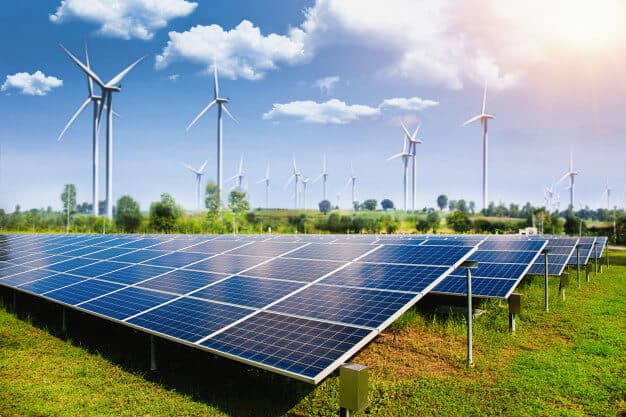What Is Renewable Energy?
The future of energy is renewable energy is energy that came from earth’s natural resources that are not finite or exhaustible; such as wind and sunlight. Renewable energy is an alternative to the traditional energy that relies on fossil fuels. It tends to be much less harmful to the environment

7 Types of Renewable Energy
1. Solar
Solar energy comes from capturing radiant energy from sunlight and converting it into heat, electricity, or hot water. Photovoltaic (PV) systems can convert direct sunlight into electricity through the use of solar cells.
Benefits
One of the benefits of solar energy is that sunlight is functionally endless. With the technology to harvest it, there is a limitless supply of solar energy. Meaning it could render fossil fuels obsolete. Relying on solar energy rather than fossil fuels also helps us improve public health and environmental conditions. In the long term, solar energy could also eliminate energy costs, and in the short term, reduce your energy bills. Many federal local, state, and federal governments also incentivize the investment in solar energy by providing rebates or tax credits.
Current Limitations
Although solar energy will save you money in the long run. It tends to be a significant upfront costs and is an unrealistic expenses for most households. For personal homes, homeowners also need to have the ample sunlight and space to arrange their solar panels; which limits who can realistically adopt this technology at the individual level.
2. Wind
Wind farms capture the energy of wind flow by using turbines and converting it into electricity. There are several forms of system uses that converts wind energy and each vary. Commercial grade wind-powered generating systems can power many different organizations; while single-wind turbines are use to help supplement pre-existing energy organizations. Another form is utility-scale wind farms, in which a contractor or wholesaler purchase. Technically, wind energy is a form of solar energy. The phenomenon we call “wind”, is due to the differences in temperature in the atmosphere combined with the rotation of Earth and the geography of the planet.
Benefits
Wind energy is a clean energy source, which means that it doesn’t pollute the air like other forms of energy. Wind energy doesn’t produce carbon dioxide, or release any harmful products that can cause environmental degradation or negatively affect human health like smog, acid rain, or other heat-trapping gases. Investment in wind energy technology can also open up new avenues. For jobs and job training, as the turbines on farms need to be well and maintained to keep running.
Current Limitations
Since wind farms are build in rural or remote areas; they are usually far from bustling cities where the electricity is scarce. Wind energy must is being transfer via transition lines, leading to higher costs. Although wind turbines produce very little pollution, some cities oppose them since they dominate skylines and generate noise. Wind turbines also threaten local wildlife like birds, which leads to their demise by striking the arms of the turbine while flying.
3. Hydroelectric
Dams are what people most associate when it comes to hydroelectric power. Water flows through the dam’s turbines to produce electricity, known as pumped-storage hydropower. Run-of-river hydropower uses a channel to funnel water through rather than powering it through a dam.
Benefits
Hydroelectric power is very versatile and can be generated using both large scale projects; like the Hoover Dam, and small scale projects like underwater turbines and lower dams on small rivers and streams. Hydroelectric power does not generate pollution, and therefore is a much more environmentally-friendly energy option for our environment.
Current Limitations
Most U.S. hydroelectricity facilities use more energy than they are able to produce for consumption. The storage systems may need to use fossil fuel to pump water. Although hydroelectric power does not pollute the air, it disrupts waterways and negatively affects the animals that live in them, changing water levels, currents, and migration paths for many fish and other freshwater ecosystems.
4. Geothermal
Geothermal heat is heat that is trapped beneath the earth’s crust from the formation of the Earth 4.5 billion years ago and from radioactive decay. Sometimes large amounts of this heat escapes naturally, but all at once, resulting in familiar occurrences, such as volcanic eruptions and geysers. This heat can be captured and used to produce geothermal energy by using steam that comes from the heated water pumping below the surface, which then rises to the top and can be used to operate a turbine.
Benefits
Geothermal energy is not as common as other types of renewable energy sources, but it has a significant potential for energy supply. Since it can be build underground, it leaves very little footprint on land. Geothermal energy is naturally replenished and therefore does not run a risk of depleting (on a human timescale).
Current Limitations
Cost plays a major factor when it comes to disadvantages of geothermal energy. Not only is it costly to build the infrastructure, but another major concern is its vulnerability to earthquakes in certain regions of the world.
5. Ocean
The ocean can produce two types of energy: thermal and mechanical. Ocean thermal energy relies on warm water surface temperatures to generate energy through a variety of different systems. Ocean mechanical energy uses the ebbs and flows of the tides to generate energy, which is created by the earth’s rotation and gravity from the moon.
Benefits
Unlike other forms of renewable energy, wave energy is predictable and it’s easy to estimate the amount of energy that will be produce. Instead of relying on varying factors, such as sun and wind, wave energy is much more consistent. This type of renewable energy is also abundant, the most populated cities tend to be near oceans and harbors. Making it easier to harness this energy for the local population. The potential of wave energy is an astounding as yet untapped energy resource with an estimated ability to produce 2640 TWh/yr. Just 1 TWh/yr of energy can power around 93,850 average U.S. homes with power annually, or about twice than the number of homes that currently exist in the U.S. at present.[4]
Current Limitations
Those who live near the ocean definitely benefit from wave energy, but those who live in landlocked states won’t have ready access to this energy. Another disadvantage to ocean energy is that it can disturb the ocean’s many delicate ecosystems. Although it is a very clean source of energy, large machinery needs to be built nearby to help capture this form energy. Which can cause disruptions to the ocean floor and the sea life that habitats it. Another factor to consider is weather, when rough weather occurs it changes the consistency of the waves, thus producing lower energy output when compared to normal waves without stormy weather.
6. Hydrogen
Hydrogen needs to be combined with other elements, such as oxygen to make water as it does not occur naturally as a gas on its own. When hydrogen separates from another element it can be use for both fuel and electricity.
Benefits
Renewable Energy the future of energy – Hydrogen can be use as a clean burning fuel, which leads to less pollution and a cleaner environment. It can also be use for fuel cells which are similar to batteries, and can be useful for powering an electric motor.
Current Limitations
Since hydrogen needs energy to be produce, it is inefficient when it comes to preventing pollution.
7. Biomass
Bioenergy is a renewable energy that came from biomass. Biomass is organic matter that comes from recently living plants and organisms. Using wood in your fireplace is an example of biomass that most people are familiar with.
There are various methods used to generate energy through the use of biomass. This can be done by burning biomass, or harnessing methane gas which is produced by the natural decomposition of organic materials in ponds or even landfills.
Benefits
Renewable Energy the future of energy – The use of biomass in energy production creates carbon dioxide that is being transfer into the air; but the regeneration of plants consumes the same amount of carbon dioxide; which creates a balanced atmosphere. Biomass can be used in a number of different ways in our daily lives, not only for personal use, but businesses as well. In 2017, energy from biomass made up about 5% of the total energy used in the U.S. This energy came from wood, biofuels like ethanol, and energy generated from methane captured from landfills or by burning municipal waste.
Current Limitations
Although new plants need carbon dioxide to grow, plants take time to grow. We also don’t yet have widespread technology that can use biomass in lieu of fossil fuels.
Contact us today to learn what we have to offer about Renewable Energy the future of energy or read more of our blogs.
Source(s): https://justenergy.com/





